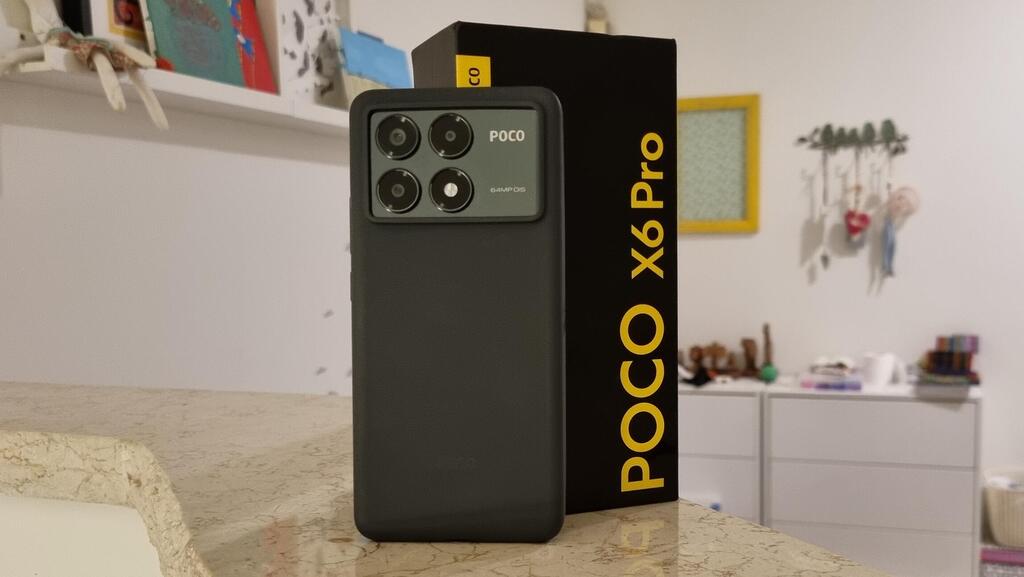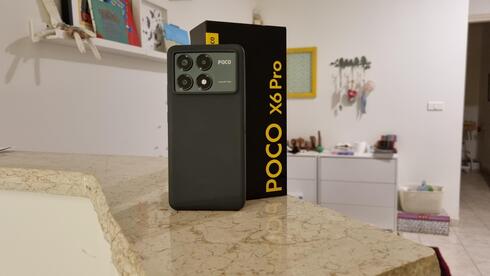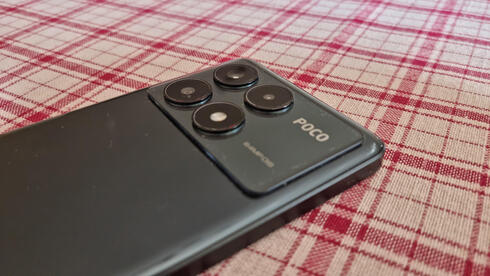
Smartphone review
Xiaomi Poco X6 Pro: An excellent mid-range device good enough for most customers
The specifications of Xiaomi's Poco X6 Pro are impressive and compete with significantly more expensive devices. But while the screen is excellent and the battery lasts for more than a day, the camera and protection of the device need to be improved
Top Line:
Xiaomi's Poco X6 Pro is one of the better devices in the mid-range category. It doesn't offer extraordinary capabilities, but its memory and storage volume are usually found in significantly more expensive devices. It doesn't heat up even when it's burdened and it has a good screen. The main weak points are the quality of the protection against water, and the camera, although it is sufficient for basic use.
Another advantage is the price. Competing devices with similar specifications can cost at least another $250, which is a significant difference.
Details:
Xiaomi has already proven several times that it knows how to produce smartphones at various levels and prices - not only cheap or mid-range devices, but also real flagship devices that can compete with those of Samsung and Apple. And yet, the feeling is that its natural place is in the development of cheaper devices. The new Poco X6 Pro, which arrives a little less than a year after its predecessor, the X5 Pro, proves this perfectly. Poco is a sub-brand of Xiaomi that offers "mid-range devices" - relatively powerful and relatively cheap smartphones. You won't find flagship devices here, there are no foldable devices or a touch pen, the protection of the device is not the best, but despite all that it is likely good enough for most customers.
Structure and design: basic, with minor changes
Externally, there is nothing really new and the design is basic and familiar from other smartphones of various companies: the X6 is almost identical to its predecessor, with differences of about 2 millimeters in the dimensions of the device. The screen remains 6.67 inches and the weight has increased by a few grams, but the device does not feel heavy.
On the back of the device there is a different arrangement of the cameras: 3 lenses protrude outward and next to them is a flashlight that also protrudes.
The protection of the device has also undergone a minor upgrade, with protection against water and dust now meeting the IP54 standard (compared to last year's IP53), but this still means that you should not walk around with it in the rain and definitely don’t immerse it in water. The screen protection remains unchanged with Gorilla Glass 5, although there are already newer and stronger versions. The back of the X6 is covered in plastic that feels high quality, but quickly collects fingerprints and smears.
The fingerprint scanner has moved to the device screen, as is common in most models. As usual with Xiaomi, the kit includes a basic protector (which also solves the issue of fingerprints on the back of the device). The cover also does not include an opening for a headphone socket, because this time there is none - Xiaomi gave it up in the new model and aligned itself with the industry. Xiaomi did not give up on another feature: an infrared light and a remote app that allows you to control the TV and other devices.
Hardware: Specs found in much more expensive devices
It's easy to complain about the lack of innovation in smartphones, and I've done it many times, but even if it's true on the outside, inside the device that is not the case.
In accordance with its status as an intermediate device, the X6 does not include a Snapdragon 8 processor as you will find in the flagship devices, but a Mediatek Dimensity 8300 Ultra processor that was launched towards the end of 2023. The memory and storage volume have been doubled compared to the previous model: the X6 comes with 12 gigabytes of memory (impressive for a mid-level device) and 512 GB of storage. The X6 doesn't feel super fast, but it handled heavy tasks without problems, and didn't even heat up.
The maximum brightness of the screen has also been doubled, to an intensity of 1,800 nits and it is noticeable - the display is clearer and more readable, and there is no problem using the device when it is under sunlight. The screen doesn't compete with those you'll find on flagship devices, but provides a very good display. The speakers are loud enough and produce a reasonable plus sound. It can be improved a little, if you go to the "sound effects" menu in the settings and turn on "surround sound" - a feature that for some reason is turned off by default.
The battery remains unchanged, which is good because it is a 5,000 mAh battery. It is enough for a day or so - depending on how the device is used. The X6 does not support wireless charging but does offer fast charging and Xiaomi, as usual, has integrated a 67-watt fast charger into the phone kit. It is true that even charging at 25 or 45 watts is fast enough, but here the gap is noticeable: I connected the device when the battery reached 15% and within 3 minutes it was already filled to 25%. After 10 minutes the battery reached 50% and after a little more than half an hour from the start of charging it was completed and the battery showed 100%.
Related articles:
Software: new-old system
The X6 comes with Android 14 and with a new interface from Xiaomi - HyperOS. At first and second glance it is hard to understand what has changed here, but there are some differences. One of the most noticeable is the shortcut screen for controlling the device, which appears next to the notification curtain. The display is different, there is no text under each icon and there is a mini player for displaying and controlling the media that is playing.
Similar to the MIUI interface, you can choose whether to display the home screen in a "classic" look, which means that all applications are displayed on the home screen and other screens, or to display an "application drawer", which opens when you drag your finger from the bottom of the screen upwards. You can change this view at any time.
Another difference - HyperOS takes up less space. The new system takes 8.8 gigabytes of the device's volume, compared to 11.85 gigabytes occupied by MIUI on other Xiaomi devices.
Beyond that, those who have used an Xiaomi device will not encounter significant differences and will not have difficulty working with the new interface.
Camera: a step back in quantity, and the quality is not the best
Last year, Xiaomi integrated a camera with a 108 megapixel sensor in the Focus X5 Pro, which did not appear by default on the photo screen. This time the company seems to admit that you shouldn't be fooled by the big numbers and the Focus X6 includes a 64 megapixel sensor "only" for wide shooting and X2 optical zoom.
There's also an 8-megapixel sensor for ultra-wide photography, a 2-megapixel sensor for macro photography, and a selfie camera with a 16-megapixel sensor.
The results are not very different from the previous model: the photos are good enough to share on WhatsApp and social networks, but not always the sharpest. Even without enlarging the photos, you can see that some of the details are a bit smeared or blurred. The camera automatically switches to night mode depending on the lighting conditions, and here the sharpness problem is a little more pronounced.
This time it is not possible to select the photo sensor in the photo screen, but only the image format. In addition, this option is not displayed in the camera's main menu, but in a sub-menu.
In the camera settings, there is also the familiar option of an AI camera, which detects the scene on its own and makes the necessary adjustments. This time there is AI in photo editing as well - you can delete people and details from photos, change the color of the sky, highlight photographed subjects and blur the background and more. These are options that are also offered by other devices and apps, and as with some competitors it is usually not completely smooth.
How does it work? Select an image, enter editing mode and then the AI menu appears. There are several options here and in some cases they are automatic: if you choose to delete someone from a photo, the application will try to identify by itself where people appear in the photo. It depends on the composition of the image: if each person appears separately and clearly the automatic identification will work, and if not - then not. You can also manually mark who you want to delete, and the same principle also works with objects. And the deletion? It also depends on the image and its complexity, as usually traces of what was in the original image remain.


